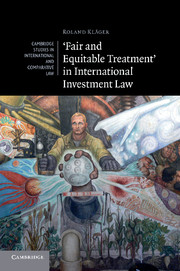Book contents
- Frontmatter
- Contents
- Foreword
- Acknowledgements
- Table of cases
- Table of treaties
- List of abbreviations
- 1 Introduction
- Part I The construction of fair and equitable treatment
- 2 Fundamentals for the construction of fair and equitable treatment
- 3 Fair and equitable treatment and the international minimum standard
- 4 The role of international law in the construction of fair and equitable treatment
- Part II The concept of fair and equitable treatment
- Part III The position of fair and equitable treatment in the international legal system
- 10 Conclusion
- Bibliography
- Index
- misc-endmatter
3 - Fair and equitable treatment and the international minimum standard
Published online by Cambridge University Press: 05 July 2011
- Frontmatter
- Contents
- Foreword
- Acknowledgements
- Table of cases
- Table of treaties
- List of abbreviations
- 1 Introduction
- Part I The construction of fair and equitable treatment
- 2 Fundamentals for the construction of fair and equitable treatment
- 3 Fair and equitable treatment and the international minimum standard
- 4 The role of international law in the construction of fair and equitable treatment
- Part II The concept of fair and equitable treatment
- Part III The position of fair and equitable treatment in the international legal system
- 10 Conclusion
- Bibliography
- Index
- misc-endmatter
Summary
A The emergence of a controversy
In the spotlight of a long-standing doctrinal debate stands the question of whether the concept of fair and equitable treatment is limited to the international minimum standard of customary international law, or whether it is to be constructed independently, as a self-contained standard highlighting the plain meaning of ‘fair’ and ‘equitable’. Thereby, proponents of the one side try to limit the range of justificatory arguments on fair and equitable treatment mainly to historical arguments derived from the international minimum standard. Then again, others concentrate on textual arguments based on the wording of fair and equitable treatment. However, before examining the details of each of the different opinions, it appears quite expedient to explore the classical concept of this so-called minimum standard, since it forms the foundation upon which modern perceptions of fair and equitable treatment are grounded.
The international minimum standard
The international minimum standard is a chatoyant notion. It is built on the assumption that there is a standing body of customary rules protecting a foreign individual in another country. The minimum standard is thus asserting a level of protection for the foreigner, below which the treatment provided for by the host state must not fall. The law concerning the protection of individuals abroad received a great deal of attention in the late nineteenth and first half of the twentieth century. It was primarily at this time when the basic features of this field of law were being elaborated.
- Type
- Chapter
- Information
- Publisher: Cambridge University PressPrint publication year: 2011

